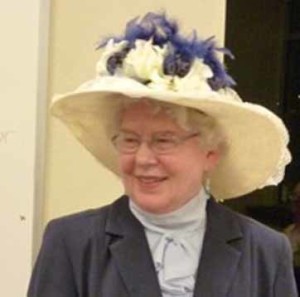 Happy New Year! Relevant History welcomes Karen Wills, who lives near Glacier National Park. She writes historical, often frontier, novels. She’s practiced law, representing plaintiffs in Civil Rights cases. She’s taught English classes at college and secondary public school levels, including on South Dakota’s Cheyenne River Sioux Reservation and in the Inupiaq village of Wales, Alaska. She’s encountered both grizzly and polar bears and still believes we need wild creatures and wilderness. Her novels include the self-published archaeological thriller Remarkable Silence and traditionally published River with No Bridge. All Too Human will be released in 2019. To learn more about her and her books, visit her web site, and follow her on Facebook and Twitter.
Happy New Year! Relevant History welcomes Karen Wills, who lives near Glacier National Park. She writes historical, often frontier, novels. She’s practiced law, representing plaintiffs in Civil Rights cases. She’s taught English classes at college and secondary public school levels, including on South Dakota’s Cheyenne River Sioux Reservation and in the Inupiaq village of Wales, Alaska. She’s encountered both grizzly and polar bears and still believes we need wild creatures and wilderness. Her novels include the self-published archaeological thriller Remarkable Silence and traditionally published River with No Bridge. All Too Human will be released in 2019. To learn more about her and her books, visit her web site, and follow her on Facebook and Twitter.
*****
I fell in love with Glacier National Park as a three-year-old in Glacier Park Lodge, a magnificent alpine structure built by the Great Northern Railway. My family attended the hotel’s evening program featuring Blackfeet tribal members dancing to drums and traditional singing.
The biggest man, wearing full regalia including a feather headdress, stepped out of the circle and beckoned me to join in the dance. Mom nodded. I slipped my hand in his. I still remember our shadows cast against the wall, mysterious silhouettes bending and rising, bending and rising.
The full history of the place that became Glacier National Park is a narrative of loss, discovery, and calculated enticements. The “Indian Wars” lurched to their painful close in the last decades of the 19th century. The romance of the Old West, the freedom of unfenced plains, the hunting of vast buffalo herds, and the culture of the Northern Plains tribes nearly vanished under soul-deadening destruction. Transitioning to reservation life, Blackfeet and others endured starvation, illness, and the forcible removal of their children to boarding schools. The government banned sacred ceremonies such as the Sun Dance.
But while Natives endured hardship, legendary names and images of the lost American West lived on the world over. European children read enthralling stories from James Fenimore Cooper to German author Karl May’s popular Wild West tales. Three of these avid readers, John Fery, Winold Reiss, and Julius Seyler, later journeyed to Montana to paint the mountains, waters, wildlife, and people in and near Glacier National Park.
“See America First”
Louis W. Hill, son of James J. Hill, founder of the Great Northern Railway, lobbied for the establishment of Glacier National Park. In 1910, President Taft signed legislation that made Hill’s dream a reality. Hill loved the Park, hunted and fished in it, and as an amateur artist, painted its mountains. President of the Great Northern, he found ways to promote the ‘Crown Jewel of the Continent’ and attract tourists to the ‘American Alps.’ He built hotels and chalets that combined being rustic with architecture and décor reminiscent of Swiss hotels. He invited Blackfeet from their nearby reservation to meet trains, and set up their lodges, their tepees, on the grounds of Glacier Park Lodge. He also hired and bought the work of artists whose depictions would entice easterners to “See America First.”
Three of Hill’s German and Austrian artists’ serious works as well as the advertising art of two of them are still sought after for color, quality, and collectors’ unending fascination with vanished, unspoiled wilderness. In his book Art Across America, William Gerdts wrote, “Railway stations and hotels served in a real sense as the first ‘art galleries’ in the West, at a time before traditional art institutions were envisioned in the region.”
John Fery
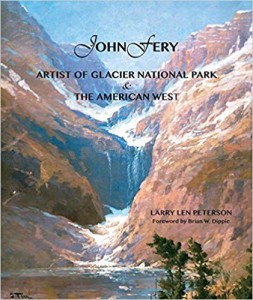 Fery, born Johann Nepomuck Levy in Strasswatchen, Austria, on 25 March 1859, moved to Milwaukee, Wisconsin, in 1883, changing his name to John Fery. An outdoorsman, he frequently left his family in Milwaukee to go west to paint. Hill noticed his work and hired him for the “See America First” campaign. Prolific, Fery created big mountainous scenes for the Great Northern that hung in Glacier National Park hotels, Great Northern depots, and ticket agent offices. Fery produced about fourteen huge landscapes per month.
Fery, born Johann Nepomuck Levy in Strasswatchen, Austria, on 25 March 1859, moved to Milwaukee, Wisconsin, in 1883, changing his name to John Fery. An outdoorsman, he frequently left his family in Milwaukee to go west to paint. Hill noticed his work and hired him for the “See America First” campaign. Prolific, Fery created big mountainous scenes for the Great Northern that hung in Glacier National Park hotels, Great Northern depots, and ticket agent offices. Fery produced about fourteen huge landscapes per month.
Finally, Hill told him to paint his illustration-like works in the St. Paul, Minnesota, studio that the Great Northern provided him. It seemed an interest in portraits of Blackfeet and scenes including them had arisen. Hill wanted artists who could fill the demand. He called the Blackfeet his “Glacier Park Indians.”
Julius Seyler
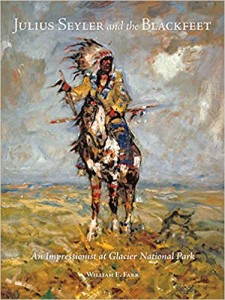 Julius Seyler was born in Munich, Germany, in 1873. He studied art but also became a competitive ice skater. He achieved fame for both his impressionist art and prowess at speed skating before he came to America.
Julius Seyler was born in Munich, Germany, in 1873. He studied art but also became a competitive ice skater. He achieved fame for both his impressionist art and prowess at speed skating before he came to America.
He, too, felt a fascination with the American West, especially the Blackfeet of the Northern Plains. He’d married an American from St. Paul who had a family connection to Louis Hill. The men met and Seyler soon found himself traveling west with Hill in the tycoon’s private rail car, headed toward Glacier Park and the Blackfeet reservation.
Seyler fell under the spell of the Rockies and the Blackfeet. He painted them, struggled to learn all he could about and from them—and the tribe adopted him. While he never worked for the Great Northern, he sold art to the company. Hill’s home in St. Paul had private showings of Seyler’s work, paintings that memorialized the vanished frontier.
Still a German citizen of fighting age when WWI broke out, Seyler fell out of favor with American art buyers including Hill. Unable to return to Germany, Seyler and his wife farmed in Wisconsin until the War’s end, when they returned to Germany.
Winold Reiss
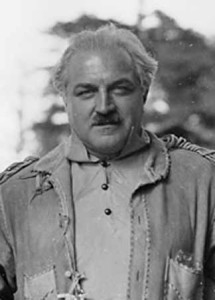 Our third artist, Winold Reiss, was born in Karlsrhuh, Germany, in the Black Forest region, in 1888. He sailed to America in 1913 eager to paint Indians, eventually finding his way to Glacier National Park. While Julius Seyler painted iconic Native American types, Reiss focused in detail on Blackfeet individuals, their features and clothing. His realism appealed to Hill. Reiss’s work, starting in 1933, appeared on calendars and even menus for the Great Northern Railway.
Our third artist, Winold Reiss, was born in Karlsrhuh, Germany, in the Black Forest region, in 1888. He sailed to America in 1913 eager to paint Indians, eventually finding his way to Glacier National Park. While Julius Seyler painted iconic Native American types, Reiss focused in detail on Blackfeet individuals, their features and clothing. His realism appealed to Hill. Reiss’s work, starting in 1933, appeared on calendars and even menus for the Great Northern Railway.
My work in progress, Garden in the Sky, has one character inspired by the German/Austrian artists of Glacier. They and other artists, as William Farr wrote “…chose to make the Old West last as long as they could.” Perhaps that’s what we authors of frontier novels like my River with No Bridge and soon-to-be-released All Too Human attempt as well.
Sources:
o Farr, William E. Julius Seyler and the Blackfeet: An Impressionist at Glacier National Park, Norman: University of Oklahoma Press, 2009.
o Peterson, Larry Len. The Call of the Mountains: The Artists of Glacier National Park. Tucson, Arizona: Settlers West Galleries, 2002.
o Saar, Meghan: Glacier’s Great Artists (https://truewestmagazine.com/author/meghan)
*****
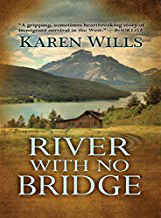 A big thanks to Karen Wills! She’ll give away a hardback copy of River with No Bridge to two people who contribute a comment on my blog this week. I’ll choose the winner from among those who comment by Friday at 6 p.m. ET. Delivery is available in the U.S. only.
A big thanks to Karen Wills! She’ll give away a hardback copy of River with No Bridge to two people who contribute a comment on my blog this week. I’ll choose the winner from among those who comment by Friday at 6 p.m. ET. Delivery is available in the U.S. only.
**********
Did you like what you read? Learn about downloads, discounts, and special offers from Relevant History authors and Suzanne Adair. Subscribe to Suzanne’s free newsletter.

I won’t qualify for the giveaway as I live in Scotland, but wanted to comment anyway as I found this piece so interesting. My husband and I visited Montana in 2008 because of a poster I’d bought on a visit to Denver some years earlier of a work by Charles M Russell. We were invited to a family wedding in Seattle but wanted to travel further afield after the event. “Let’s go there” I suggested, pointing at the poster which mentioned the CM Russell Museum in Great Falls. It was the best holiday we’ve ever had, we loved Montana and can’t understand why it isn’t better known in Europe as a holiday destination.
Hi Janet,
I’m so pleased you love Montana as much as I do. Russell had a home/studio, Bull Head Lodge, in Glacier National Park on the shores of Lake McDonald. You probably saw some of the paintings he created there. There is also a Russell gallery in the Montana History Museum next to our state capitol in Helena. My favorite is When the Land Belonged to God. I hope you can return one day.
I am on the fence about how to be a responsible author (I write historical and fantasy fiction). I wonder about my “right” to include on my page a cultural group who has been victimized by those in my own heritage. In my writer’s role, I am an active historian, and I work hard to find stories belonging to the original voices, but those stories aren’t always available. When we can only use second hand accounts, are we still being “good researchers” and “responsible writers.” Or are we merely tourists? I find I cannot answer this. I wonder what is your opinion….
According to Sherman Alexie, who I met & dislike, if you are white you should not have ANY American Indian characters. Period. But if you do, you must donate ALL profits to some tribal folk. With all his critical & commercial financial success, I guess he ought to donate to Sons of Norway because of all the bad or just ignorant white characters he has in his books, right? I would say, not only do diligent research, but go meet some Native people. Look around & find out when is the next & closest Pow Wow. Attend & talk to the people. Note: NEVER comment about “costumes” the outfits are called “regalia” and the people enjoy questions or compliments on their regalia–most of which they’ve made themselves. My son is Southern Cheyenne & Mescalero Apache. He does not pass for white. I, a mainly Norwegian white woman had to educate him about half his heritage, which I also taught to my daughter. I did this through research, and even made “flash cards” of works of art by famous Indian artists, quizzed both kids, made them identify jewelry & pottery styles, learn old stories from various tribal traditions, but most important: Once a month we went to a local Pow Wow. I had Indian (this might not sound “PC” but the tribal folk do NOT say “Native American” unless they feel like being snoots, they say “Indian” and sometimes “American Indian” for general terms, but usually just use the name(s) of their tribes) friends & several of the men were excellent mentors to my son. This connection not only helped my son, it enriched the lives of my daughter & I. As a last note, I present to you the late great Tony Hillerman, who I had the pleasure of meeting at the same event where I met Alexie. He was a white guy. What do you think the Navajo Nation thinks of him?
That’s some good advice, Karen. The exclusionary way Sherman Alexi talks about non-native authors really is ridiculous, but then Edward Said says more or less the same thing. Being white, we can only write white. I write about 17th century peasants. I’m sure many would say (perhaps rightly) that I don’t deserve to write about peasant cultures I can’t possibly understand, white, brown or otherwise. I am not a peasant, I don’t come from a mountain culture, I was not born into a rural community without running water or medical care. But does that mean we white people should simply do the research into these things that interest us and then . . . keep it to ourselves? I try to write about marginal cultures, I suppose because I have always felt like a person on the fringes. And like your family, I’m a child of two continents. But even if I were a lily white Yankee from New England who never met a person of color, I don’t think that means said Yankee should be prevented from learning about and writing about minority cultures. She should be encouraged. Ah well, there ends my rant. Thank you for replying. I blog at laurambendoly.wordpress.com if you’re interested. LB
Laura, write what you’ve researched and feel you can accuarately represent. Challenge yourself. Put it out there, and ignore the nay-sayers. Playing it safe guarantees that you’ll never be able to draw the line anywhere.
In my historical mystery series, I write about redcoats and Continental soldiers, Indians, patriots, loyalists, Spaniards, French, Dutch, Jews, and a Muslim or two, not to mention the various trades that come into play. How much of that do you think I’ve been/done?
In my science fiction series set on a non-Earth world in the 24th century, one population of humans descends from an entire village of Sumerians that was jacked from Earth 6000 years ago. It’s ludicrous for anyone to tell me that I cannot imagine humans who have experienced 6000 years of cultural divergence from Earth people — just because I’m not Sumerian.
Hi Laura,
Good for you for approaching depiction of members of another culture with respect and sensitivity. All we can do is be as responsible and honest in our research as possible. Primary sources are always best, but as you say can be hard to find. I try to find the voices that have authenticity.
I taught school in an Inupiaq village in Alaska. I hope someday to write an historical YA set there. I’ll have to rely somewhat on anthropological evidence about those who came over on the land bridge from Asia. It’s more important to preserve what history we have than to let a culture disappear. We can preserve something of it through art and fiction.
I also don’t believe anyone owns a culture, although people can be outspoken members of their cultures. When the rough draft of my work in progress is finished, I’m going to seek out an appropriate Blackfeet tribal member to read and comment on the parts having to do with Blackfeet culture.
So much of this not only interested to me as a Historian, but resonated at a personal level. I’m from Wisconsin and although I wound up in Colorado when I got out of the Army, in many ways Wisconsin is still “home” as is Minnesota, since the two states are almost identical in landscape, topography, history, language (we speak the same dialect) and people. While in the Army, I had the pleasure to live in Germany for 5 years. Also while in the Army, I had the pleasure of serving with tribal people other than the Wisconsin folk & got to know the Blackfeet.
Hi Karen,
I’m also familiar with Minnesota and Wisconsin having lived in Grand Forks, North Dakota, just across the Red River from Minnesota. You made the most of your Army experience. Thank you for your service.
I’m glad to know more about Glacier; I was there in September but because of the stormy weather, I could not see much of the park or read any of the offered history.
I’m also intrigued by the German artists living in America during WWI. Especially Winold Reiss, who came to America just before the war. What did these artists do to survive during a period when Germans were hated and hunted?
Karen…do you touch on that immigrant experience in your stories?
Hi Ana,
Between fires and bad weather, Glacier had a rough late summer and early fall. I hope you’ll have another chance to visit sometime when the Park is at its best.
I’m not sure how Winold Reiss did during WWI. Nothing I read indicated that he had as bad a time as Julius Seyler. Perhaps Reiss had become a U.S. citizen, although they, too, had it rough in many parts of the country.
Seyler and his American wife did have a tough time. Her parents lived in St. Paul, Minnesota, but had a small farm in a remote part of Wisconsin. The couple lived there and tried their best to make a profit at farming. Seyler wasn’t a farmer, but he read everything he could get his hands on and worked very hard. It was never truly successful.
Yes, I do write about the immigrant experience in River with No Bridge. My protagonist is a poor young Irish immigrant woman who travels west to marry a miner in Butte, Montana. Her life takes unexpected turns that call on all her strength and resourcefulness.
I enjoyed this post for several reasons. First, I am pleased to be introduced to a new-to-me author. I love the artwork on those old railway posters. If I were wealthy, I would collect them. Learning more about the actual artists was intriguing.
To the other question of writing only what we are, wouldn’t that be boring? In my books, I write the culture of the locale and that includes European white, Hispanic, Indian, and black characters. I don’t intend to change this practice.
Thank you for an interesting post.
Hello Caroline,
I’m so glad you enjoyed the post. I, too, love the artwork. Each artist had an eye for different aspects of the region. It’s hard to beat Reiss’s portraits of individual Blackfeet.
And yes, I like to read historical novels with different settings and cultures represented. That’s where we learn and discover. Well, that and doing the research for writing them.
Really interesting article.
It would have been interesting to be an artist in the old West
Thank you, Joye. I agree that these artists had interesting lives. The German artists missed the true old West, but had a chance to meet those who had, at least as children, known what it was like before the buffalo were gone.
How awesome – it sounds like a super book and she lives near me – thanks for the contest
Thank you, Taylor. I hope you’ll read River with No Bridge. Since you live nearby you’ll recognize many of the places where the story takes place.
The books about the artists sound very interesting, as do the books by Ms. Wills. I’m never going to be able to read all the books I want to, but I like to try, and will definitely try to get River With No Bridge into my TBR pile soon!
Thank you Kate. I hope River with No Bridge will make it into your TBR pile. Karen
Love the the stories about the Blackfoot American Indians and how beautiful the Glacier National Park is. By the way, my father’s last name is also Wills.